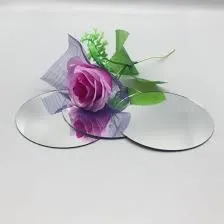

The Allure and Versatility of Mirror Glass Design
Mirror glass design has emerged as a prominent trend in the realm of architecture and interior design. This sophisticated material is not only aesthetically pleasing but also serves a multitude of functional purposes, making it a favorite choice among designers and homeowners alike. In this article, we will explore the various applications, benefits, and creative possibilities that mirror glass can offer.
Aesthetic Appeal
One of the most striking features of mirror glass is its ability to enhance the visual appeal of any space. Whether used in residential or commercial settings, mirror glass reflects light and creates an illusion of spaciousness. This is particularly beneficial in smaller areas, where the addition of mirror elements can make a room feel larger and more open. Designers often incorporate mirror glass in walls, ceilings, or even furniture, transforming ordinary rooms into extraordinary spaces filled with depth and brightness.
Additionally, the reflective properties of mirror glass can introduce a sense of elegance and sophistication. It can serve as a statement piece, drawing the eye and sparking conversation. High-end restaurants, boutiques, and hotels often utilize mirror glass for this very reason, creating striking environments that leave a lasting impression on visitors.
Functional Benefits
Beyond its aesthetic qualities, mirror glass is also highly functional. Its reflective surface can increase natural light, reducing the need for artificial lighting during the day. This not only enhances the ambiance of a space but also contributes to energy efficiency, making it an environmentally friendly choice. Moreover, the use of mirror glass can help in controlling temperature levels, as it can reflect heat away in warmer months, thus maintaining a more comfortable indoor climate.
Additionally, mirror glass is easy to clean and maintain. Unlike traditional glass, which may require specialized cleaning agents, mirror glass can often be wiped down with a simple glass cleaner. This low maintenance makes it a practical option for busy households or high-traffic commercial areas.
Creative Applications

The versatility of mirror glass extends beyond traditional uses. Designers are increasingly experimenting with innovative applications that push the boundaries of conventional décor. For instance, mirrored furniture—such as coffee tables, cabinets, or accent chairs—adds a touch of glamour to interiors while providing practical storage solutions. These pieces can also serve as focal points, effortlessly elevating the overall design scheme.
In addition to furniture, mirror glass can be creatively utilized in art installations. Sculptures and wall art made from mirror glass can create stunning visual effects, reflecting the surrounding environment and creating an interactive experience for viewers. This dynamic interaction with light and space can transform any area into an engaging and captivating setting.
Moreover, mirror glass can also be used in outdoor designs. For example, reflective pool surfaces or mirrored garden sculptures can create a seamless blend between nature and contemporary design, providing a tranquil atmosphere while highlighting the beauty of the landscape.
Trends and Considerations
As mirror glass continues to gain popularity, several trends are emerging within the design community. One notable trend is the use of colored or tinted mirror glass, which adds an unexpected twist to traditional applications. These tinted mirrors can provide a unique aesthetic while still maintaining the core benefits of reflective glass.
However, when incorporating mirror glass into design, it is essential to consider the balance of reflective surfaces within a space. Overuse of mirror glass can lead to a disorienting environment, so thoughtful placement is key. Designers often recommend pairing mirror glass with softer, more organic materials to create a harmonious balance that is visually appealing without overwhelming the senses.
Conclusion
Mirror glass design is more than just a fleeting trend; it is a timeless choice that combines beauty, functionality, and creativity. Its ability to reflect, refract, and transform spaces makes it an invaluable asset in both residential and commercial environments. As designers continue to explore the possibilities of this versatile material, we can expect to see even more innovative uses that challenge the boundaries of traditional design. Whether elevating a corner of your living room or serving as a centerpiece in a public space, mirror glass is poised to remain a staple in the world of design for years to come.